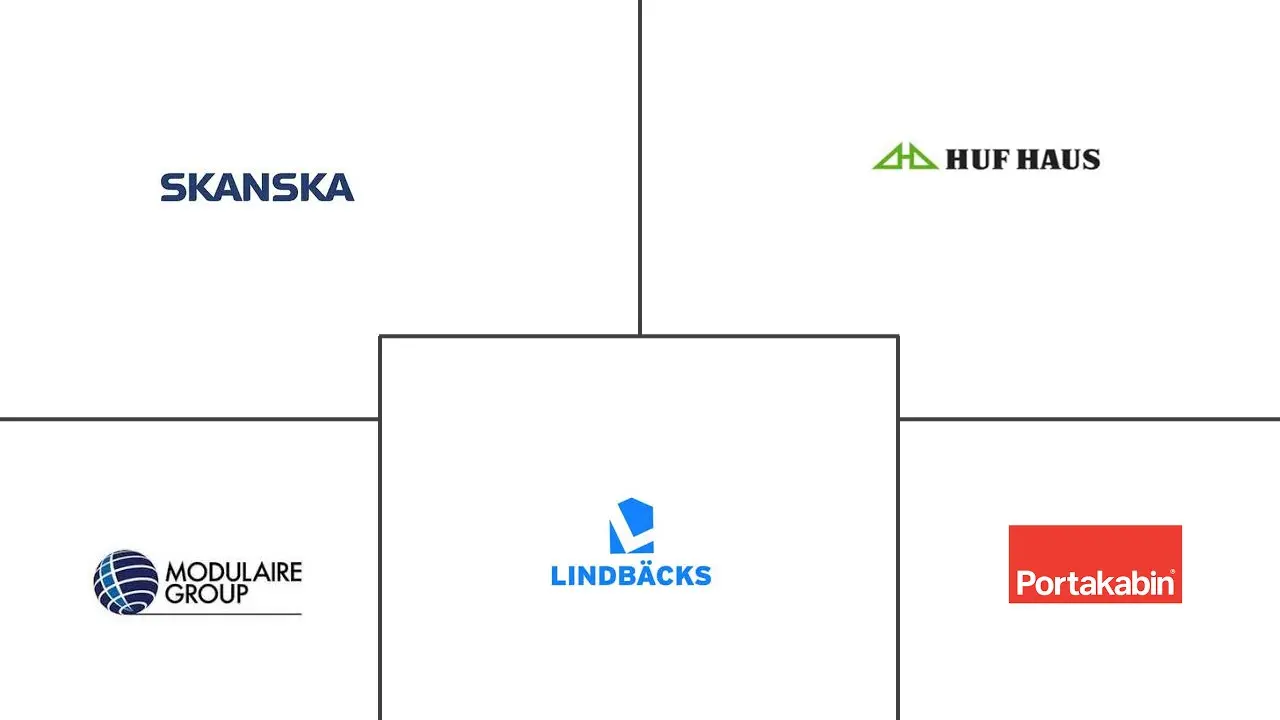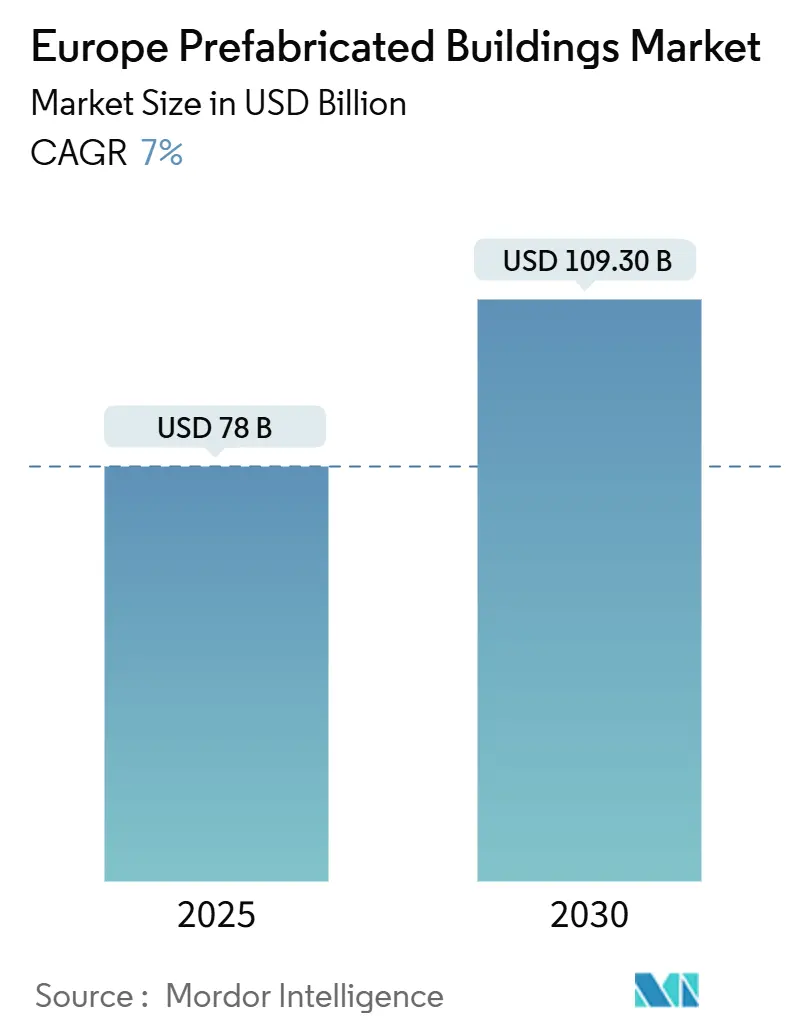
Europe Prefabricated Buildings Market Analysis by Mordor Intelligence
The Europe prefabricated buildings market size is estimated at USD 78.0 billion in 2025 and is expected to reach USD 109.3 billion by 2030, at a CAGR of 7.0% CAGR during the forecast period (2025 - 2030). Demand gains reflect the alignment of off-site manufacturing with tightening embodied-carbon rules, growing ESG capital flows, and chronic construction labor shortages that favor factory-based production. Pan-European directives now require life-cycle carbon disclosure, giving prefabricators a measurable advantage in compliance and permitting speed[1]European Commission, “Directive 2024/1275 on the Energy Performance of Buildings,” eur-lex.europa.eu.
Digitally enabled factories in Germany, Sweden, and the Netherlands are reducing cycle times by 20-35% through predictive quality control and automated assembly sequencing[2]Laing O’Rourke, “Explore Manufacturing,” laingorourke.com. At the same time, EU Taxonomy rules unlock lower-cost green bonds for projects that use timber and other low-carbon materials, expanding the pool of institutional capital available for large-scale modular programs. Collectively, these forces keep the Europe prefabricated buildings market on a structural growth path even as conventional on-site activity faces slowing building permits and cost overruns.
Key Report Takeaways
- By material type, timber captured 36.12% of Europe prefabricated buildings market share in 2024; concrete is projected to expand at a 7.69% CAGR between 2025-2030.
- By application, residential accounted for 44.20% of the Europe prefabricated buildings market size in 2024, while industrial and logistics is advancing at a 7.34% CAGR between 2025-2030.
- By product type, modular systems held 46.00% revenue share of the Europe prefabricated buildings market in 2024 and are growing at 7.62% CAGR between 2025-2030.
- By geography, Germany led with 21.55% revenue share in 2024; Sweden posts the fastest 7.83% CAGR between 2025-2030.
Europe Prefabricated Buildings Market Trends and Insights
Drivers Impact Analysis
| Driver | (~) % Impact on CAGR Forecast | Geographic Relevance | Impact Timeline |
|---|---|---|---|
| EU-level embodied-carbon caps | +1.8% | EU-wide, early uptake in Nordics and Germany | Medium term (2-4 years) |
| Persistent skilled-labor shortages | +1.5% | Germany, France, United Kingdom | Short term (≤ 2 years) |
| Hyperscale data-center rollout | +1.2% | Germany, Netherlands, Ireland, Nordic region | Medium term (2-4 years) |
| Green social-housing funds | +1.0% | Spain, Germany, Netherlands | Long term (≥ 4 years) |
| EU Taxonomy green-bond access | +0.9% | EU-wide, strongest in ESG-focused capital markets | Long term (≥ 4 years) |
| Industry 4.0 digital-twin factories | +0.6% | Germany, Sweden, Netherlands | Medium term (2-4 years) |
| Source: Mordor Intelligence | |||
EU-level embodied-carbon caps accelerating off-site construction
Member-state implementation of the revised Energy Performance of Buildings Directive requires all new homes to disclose life-cycle carbon as early as 2027, with Denmark tightening limits to 7.1 kg CO₂e/m²/year beginning July 2025[3]Nordic Council of Ministers, “Danish CO₂ Limits for New Buildings,” nordicsustainableconstruction.com. Factory-built solutions consistently achieve 20-30% lower embodied carbon because controlled environments optimize material use and facilitate closed-loop waste recovery, giving compliant manufacturers a clear route to planning approvals and green financing. Digital product passports mandated under the 2024 Construction Products Regulation further favor standardized components whose emissions are traceable from cradle to gate. Prefabricators are therefore scaling capacity ahead of the enforcement timetable to secure early-mover contracts, particularly in Germany and the Nordics where municipalities have already embedded carbon ceilings in tender documents. The regulatory certainty is translating into long-term offtake agreements that underpin investment in next-generation volumetric lines.
Persistent skilled-labor shortages across Western Europe
Vacancy rates in European construction reached a decade high in 2025 as retirements outpaced new entrants and wage inflation cut margins for traditional contractors. Prefabrication addresses this structural gap by shifting up to 90% of trade hours into automated factories where training cycles are shorter and safety conditions are superior. Swedish plants already post 30% higher labor productivity than comparable on-site crews, proving how standardized workflows unlock scale without proportional head-count growth. Governments view the model as a route to maintain housing targets despite tight labor markets, which is why Germany’s KfW climate-friendly new-build program links subsidized loans to projects demonstrating off-site assembly ratios. Near-term momentum therefore hinges on employers’ ability to retrain workers for digitized factory roles rather than traditional wet-trade skills.
Rapid hyperscale data-center rollout needing long-span PEBs
European cloud and AI providers face a capacity deficit that demands more than 3 GW of new server space by 2030, pushing developers toward pre-engineered metal buildings that cut delivery schedules by up to 40%. Long-span portals and modular MEP racks are manufactured in controlled environments, shipped just-in-sequence and bolted together on-site, allowing concurrent fit-out of critical power and cooling systems. The approach has become standard in the Netherlands and Ireland where energy-permitting windows are short and grid connections dictate fast track timelines. German industrial hubs are now adopting similar playbooks, encouraged by regional incentives for AI infrastructure that specify embodied-carbon reporting—an additional advantage for factory-produced steel sections incorporating recycled feedstock.
Member-state green social-housing funds favor volumetric units
Recovery and Resilience Facility allocations earmark more than EUR 5.5 billion for social housing construction, with Spain and the Netherlands issuing tenders that score bids on delivery time and operational energy intensity. Volumetric timber or hybrid modules arrive with façades, services and finishes already integrated, enabling 50–60% faster commissioning than conventional methodologies. Early projects financed by the European Investment Bank in Catalonia demonstrate unit handover in under nine months, meeting disbursement milestones linked to affordable-housing KPIs. Because funders demand post-occupancy performance data, the standardized volumetric approach simplifies measurement and verification, further reinforcing its preference in public procurement.
Restraints Impact Analysis
| Restraint | % Impact on CAGR Forecast | Geographic Relevance | Impact Timeline |
|---|---|---|---|
| Cross-border permitting fragmentation within EU/EEA | -1.2% | EU-wide, particularly affecting cross-border manufacturers | Short term (≤ 2 years) |
| High last-mile logistics cost for oversize modules | -0.8% | Concentrated in island markets and remote regions | Medium term (2-4 years) |
| Limited CLT & LVL supply versus fast-growing demand | -0.6% | Nordic supply regions vs. Central/Southern European demand | Short term (≤ 2 years) |
| VAT-treatment complexity on intra-EU modular transfers | -0.4% | Cross-border trade routes, particularly Germany-France-UK corridors | Medium term (2-4 years) |
| Source: Mordor Intelligence | |||
Cross-border permitting fragmentation within EU/EEA
The Construction Products Regulation introduces unified CE-marking and digital product passports, yet member-state interpretations of fire safety or seismic criteria still diverge, forcing prefab producers to carry multiple certification sets and redesign modules for each jurisdiction. Implementation timelines stretch to 2028, prolonging uncertainty and increasing engineering overheads that smaller manufacturers cannot amortize. Germany’s stringent DIN standards on timber connections, for example, add structural reinforcement costs when exporting to France, where Eurocode adaptations are less prescriptive. Until harmonization matures, the Europe prefabricated buildings market will incur parallel design and testing expenses that suppress margin expansion.
High last-mile logistics cost for oversize modules
Oversized modules often exceed 3.5 m in width, triggering special permits, escort vehicles, and off-peak delivery windows that inflate transport budgets by 50–100% relative to palletized panel systems. Urban congestion in historic city centers compounds the challenge, while narrow alpine routes restrict articulated lorry access to resort developments in Austria and Italy. Prefabricators are experimenting with collapsible volumetric frames and on-site unfolding mechanisms to fit within standard trailers, but these solutions add manufacturing complexity. Until pan-European road regulations standardize oversize allowances, distance will remain a price-setting factor that limits the addressable radius of volumetric factories.
Segment Analysis
By Material Type: Timber’s dual leadership underpins carbon-first procurement
Europe's prefabricated buildings market share reflects its suitability for both volumetric housing and multi-storey commercial schemes, where cross-laminated timber delivers high strength-to-weight ratios and four-hour fire ratings [4]Churkina et al., “Timber-Based Building Typologies Carbon Analysis,” frontiersin.org. The EU Taxonomy identifies engineered wood as a primary pathway to “Substantial Contribution” status, drawing in pension and sovereign wealth funds that view biogenic carbon storage as a hedge against future carbon pricing. Scandinavian supply chains currently dominate CLT exports, but capacity additions in Austria and Germany aim to mitigate lead-time bottlenecks.
Concrete holds a sizeable portion of the precast market, particularly for parking structures and industrial slabs, where controlled curing reduces embodied carbon relative to in-situ pours. Metal remains the default for long-span data center shells and logistics hubs, benefiting from high recycling rates that now exceed 90% in European steel production. Hybrid systems are gaining traction as designers specify timber cores paired with concrete podiums to optimize seismic resilience while retaining carbon benefits. Supply risk for structural wood is the principal headwind; certification bodies recorded a 12% shortfall in CE-marked CLT volumes in 2024, prompting research into laminated bamboo and agrifiber panels as complementary feedstocks that can widen material choice without compromising circularity targets.
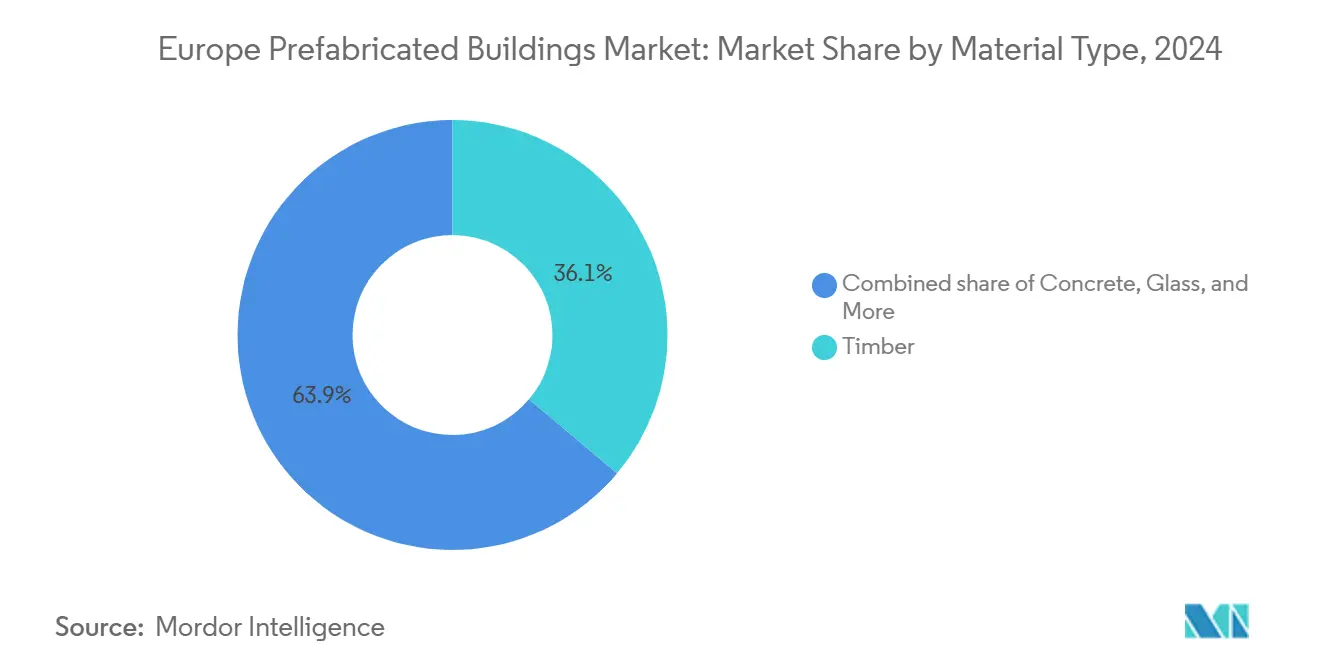
Note: Segment shares of all individual segments available upon report purchase
By Application: Industrial logistics redefines growth trajectories
Residential construction remains a significant contributor to Europe's prefabricated buildings market. However, the industrial and logistics segment is growing at a faster pace, fueled by the increasing demand for quick-deployment warehouses driven by e-commerce and on-shoring trends. Prefabrication is particularly well-suited for the repetitive layouts of distribution centers and the functional needs of data halls, where standardized floor plates enable efficient component prefabrication. Developers benefit from earlier rental income by adopting modular envelopes and MEP cassettes, which enhance the project's overall financial performance.
Commercial projects, such as hotels, schools, and healthcare facilities, are increasingly using modular classrooms and ward blocks to minimize disruptions on active campuses. In Sweden, a significant portion of detached houses already incorporates factory-produced elements, showcasing the potential for broader adoption across mainland Europe as building codes evolve and consumer perceptions shift. Public housing agencies are leveraging volumetric apartments to achieve EU renovation goals, combining energy retrofits with rapid infill on municipal land. Additionally, industrial designers are adapting logistics layouts for multi-storey manufacturing, signaling a convergence of applications as prefab suppliers expand their system platforms across various user categories to capitalize on economies of repetition.
By Product Type: Modular systems capture scale economics
Modular buildings are a significant part of Europe's prefabricated buildings market and are expected to lead growth in the coming years. Fully finished volumetric units leave the factory with MEP, interior finishes, and façades already in place, leaving only foundations and utility hook-ups as the primary on-site tasks. This high off-site completion ratio enables predictive scheduling and shortens project cash cycles, making it particularly appealing to institutional developers managing projects across multiple regions. At Europe's largest pre-assembly plant near Nottingham, the Design-for-Manufacture-and-Assembly principles allow modules to share a common chassis across various building types, significantly reducing engineering costs.Panelized and componentized systems continue to play a crucial role, especially in scenarios where transport constraints or custom architectural designs make volumetric solutions less feasible. Kitting wall, floor, and roof cassettes at construction logistics centers helps reduce site congestion and minimizes lifting capacity requirements, which is particularly advantageous in historic city centers with crane restrictions.
Hybrid approaches, which combine volumetric bathrooms and MEP risers with panelized façades, offer a balance between speed and design flexibility. Looking ahead, robotic assembly lines for steel and timber panels are being tested. If successful, these advancements could reduce costs and expand the market for componentized solutions within Europe's prefabricated buildings sector.
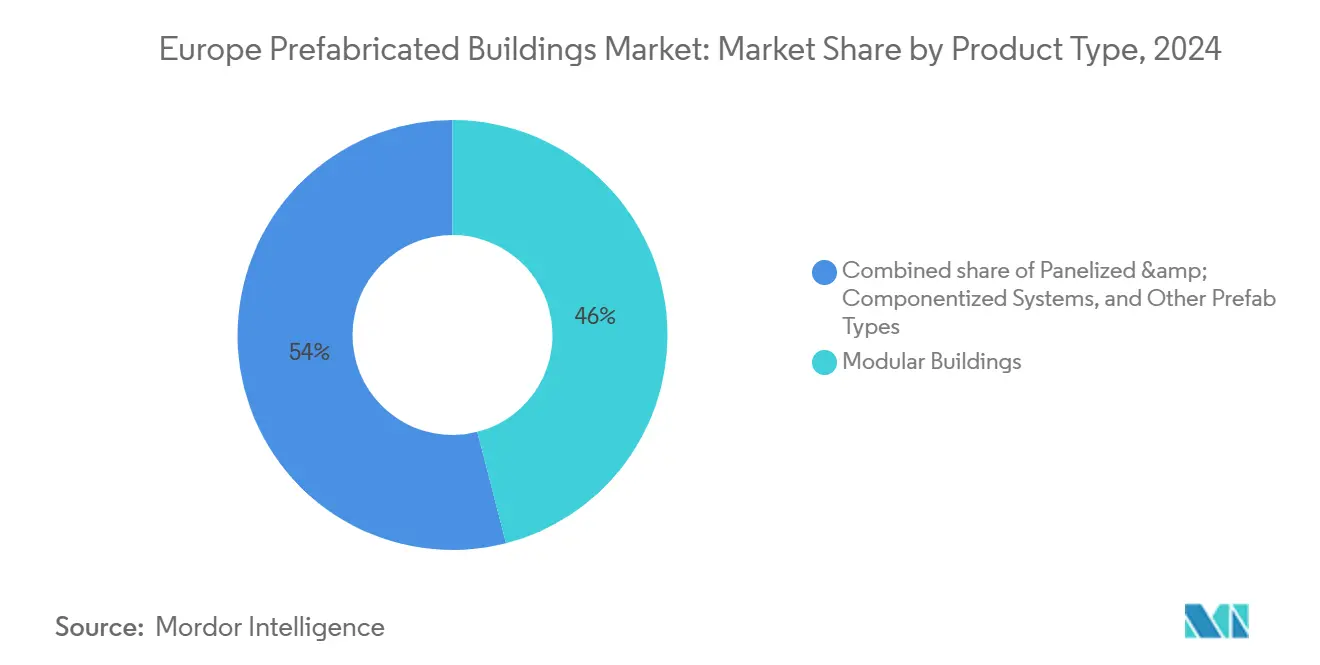
Note: Segment shares of all individual segments available upon report purchase
Geography Analysis
Germany anchored 21.55% of the Europe prefabricated buildings market in 2024, supported by a deep manufacturing base and state-backed energy-efficient housing incentives that provided EUR 762 million in subsidized loans last year. Federal carbon ceilings and BIM mandates accelerate adoption across residential and public infrastructure, yet declining building permits introduce cyclical risk for smaller subcontractors. Sweden powers the fastest 7.83% CAGR, leveraging an 84% prefab share in detached housing and a mature engineered-timber supply chain that feeds export markets across the Baltic Sea.
The United Kingdom is pivoting from pilot programs to institutional scale despite several mid-tier modular start-ups entering administration in 2024; alliances such as IKEA-Skanska’s BoKlok offer proven Nordic designs that suit British planning frameworks and aim for 1,200 units annually. France presents mixed signals: large contractors post healthy backlogs, yet cultural preference for traditional masonry slows widespread prefab penetration even as new carbon regulations push developers to explore hybrid timber-concrete solutions. Southern Europe, led by Spain and Italy, benefits from EU-financed social-housing pipelines, with Catalonia alone scheduled to add 4,300 energy-efficient rentals by 2028 using volumetric models.
The Benelux region capitalizes on dense logistics corridors and stringent nitrogen caps that encourage off-site methods capable of minimizing heavy-duty site traffic. Poland and the wider Visegrád group illustrate latent potential: modern steel plants and competitive labor rates could position the region as an export hub, yet local code alignment and client awareness need strengthening before volumes take off. Overall, geographic convergence is emerging through cross-border component supply chains and integrated digital platforms that allow design once and build many times, reinforcing the pan-regional nature of the Europe prefabricated buildings market.
Competitive Landscape
Market structure remains moderately fragmented: the largest groups hold a significant share of revenue, while numerous niche specialists cater to local segments. Brookfield’s acquisition of Modulaire Group highlights growing institutional confidence in rental-based modular assets that provide steady cash flows across multiple European countries. Skanska, Bouygues Construction, and Laing O’Rourke stand out through vertically integrated manufacturing, digital-twin platforms, and strong ESG reporting, which attract infrastructure and corporate clients.
White-space competition is intensifying in timber high-rise systems, automated component robotics, and data-center shells, where start-ups use single-product expertise to secure design-build packages. Swedish player PCS Modulsystem expanded its education and healthcare portfolio following a private-equity-backed buy-out aimed at consolidating Nordic market share. UK-based volumetric factories are utilizing machine-learning inspection tools to improve first-time-fit rates, leading to warranty cost savings that cost-conscious public buyers increasingly value.
Intellectual-property barriers are primarily based on proprietary connection details, façade systems, and automation software rather than patents, allowing fast followers to enter the market unless incumbents sustain continuous R&D efforts. Strategic alliances between steel mills and modular assemblers are emerging to secure low-carbon feedstock under long-term offtake agreements, emphasizing the importance of supply-chain integration. Considering the current share distribution and ongoing consolidation, market concentration is expected to tighten slightly by 2030 but is likely to remain below oligopoly levels, maintaining competitive dynamics that drive innovation in the Europe prefabricated buildings market.
Europe Prefabricated Buildings Industry Leaders
-
Skanska AB
-
Modulaire Group (Algeco Scotsman)
-
Lindbäcks Bygg
-
Portakabin Ltd
-
Huf Haus
- *Disclaimer: Major Players sorted in no particular order
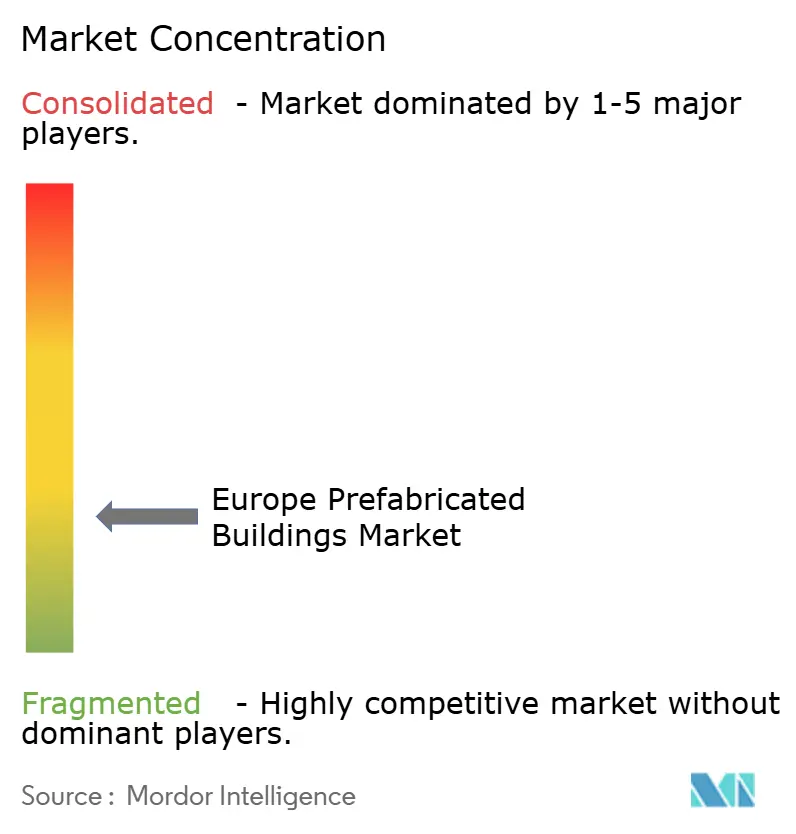
Recent Industry Developments
- March 2025: Norvestor VIII and MG Link acquired 100% of PCS Modulsystem AB to create a dedicated Nordic modular construction platform.
- February 2025: Germany’s federal KfW bank reopened climate-friendly new-build subsidies, offering loans up to EUR 150,000 per apartment for projects meeting enhanced energy criteria.
- July 2024: The European Investment Bank signed a EUR 163 million loan with ICF toward a EUR 490 million program building 4,300 affordable rentals in Catalonia.
- June 2024: IKEA and Skanska commenced the first 173-unit BoKlok development in Bristol, bringing Scandinavian volumetric housing to the UK.
Europe Prefabricated Buildings Market Report Scope
The European prefabricated buildings market covers growing trends and projects like commercial, residential, and industrial construction. The report also covers the industry and materials used, like concrete, timber, glass, metal, and other types. The market scope has been extended to provide insights at the regional level by segmenting across geography. Along with the report's scope, it also analyzes the key players and the competitive landscape in the market. The impact of COVID-19 has also been incorporated and considered during the study.
| Concrete |
| Glass |
| Metal |
| Timber |
| Other Materials |
| Residential |
| Commercial |
| Others |
| Modular Buildings |
| Panelized & Componentized Systems |
| Other Prefab Types |
| Germany |
| United Kingdom |
| France |
| Spain |
| Italy |
| Netherlands |
| Sweden |
| Denmark |
| Norway |
| Rest of Europe |
| By Material Type | Concrete |
| Glass | |
| Metal | |
| Timber | |
| Other Materials | |
| By Application | Residential |
| Commercial | |
| Others | |
| By Product Type | Modular Buildings |
| Panelized & Componentized Systems | |
| Other Prefab Types | |
| By Country | Germany |
| United Kingdom | |
| France | |
| Spain | |
| Italy | |
| Netherlands | |
| Sweden | |
| Denmark | |
| Norway | |
| Rest of Europe |
Key Questions Answered in the Report
What is the forecast value of the Europe prefabricated buildings market by 2030?
The market is projected to reach USD 109.3 billion by 2030, reflecting a 7.0% CAGR between 2025 and 2030.
Which material holds the largest share in European prefab construction?
Timber leads with 36.12% market share in 2024 thanks to its strong fit with embodied-carbon targets.
Which application segment is expanding fastest?
Industrial and logistics facilities show the highest growth at 7.34% CAGR, driven by warehouse and data-center demand.
Why are modular systems gaining traction over panelized methods?
Fully finished volumetric modules achieve up to 95% off-site completion, cutting project schedules and improving cost certainty.
Which country is growing the fastest in prefab adoption?
Sweden posts a 7.83% CAGR due to an 84% prefab penetration rate in single-family housing and a mature engineered-wood industry.
What financing advantages do prefab projects receive under EU Taxonomy rules?
Compliant projects often secure green-bond coupons 15–25 basis points lower than conventional construction debt due to documented carbon savings.
Page last updated on:
